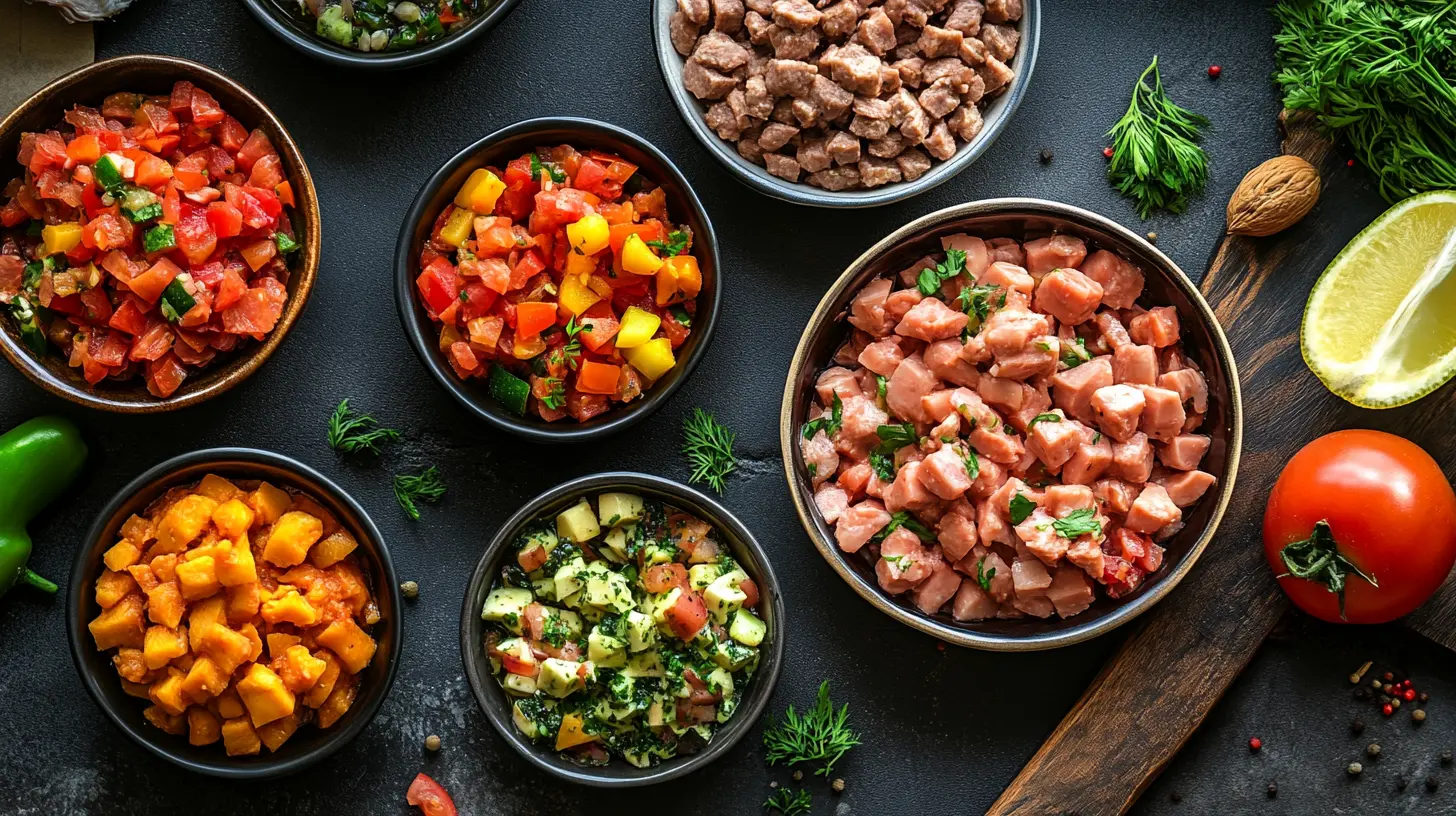In recent years, the pet food industry has witnessed a significant shift towards healthier options, with pet owners increasingly prioritizing the nutritional needs of their furry friends. As we look ahead to 2025, the demand for Healthy Wet Dog Food continues to rise, prompting manufacturers to innovate and create advanced products that not only tantalize taste buds but also support overall canine health. This comprehensive guide aims to provide global buyers with insights into the latest trends and innovations in healthy wet dog food, ensuring that pets receive the high-quality nutrition they deserve.
At the forefront of this movement is Zhangzhou Kidolon Petfood Co., Ltd., a well-known and leading manufacturer established on November 20, 2020. Specializing in the development of nutritional formulas for complete meals and snacks tailored for dogs, Zhangzhou Kidolon Petfood Co., Ltd. is dedicated to producing Healthy Wet Dog Food that meets the diverse dietary needs of pets. By focusing on quality ingredients and innovative processing techniques, the company is committed to enhancing the health and well-being of pets worldwide, making it an essential partner for buyers seeking the best in pet nutrition.

As we move into 2025, the landscape of the wet dog food market is being shaped by significant trends driven by consumer preferences and innovative formulations. According to a recent market research report by Grand View Research, the global wet dog food market is expected to reach USD 20.9 billion by 2025, growing at a compound annual growth rate (CAGR) of 5.5%. This growth is largely attributed to pet owners' increasing demand for high-quality, nutritious options that promote their dogs’ health and well-being. One of the key trends outlined in the report is the surge in interest for natural and organic ingredients. Research indicates that over 60% of pet owners are willing to pay a premium for wet dog food that is marketed as organic or free from artificial preservatives and additives. This shift is accompanied by a rise in plant-based and sustainable ingredients, reflecting a broader societal movement toward environmentally friendly products. Brands that successfully incorporate these features into their offerings are likely to capture a larger market share. Additionally, the integration of technology in product development is set to revolutionize the wet dog food sector. Smart packaging solutions and online nutrition platforms are being adopted to enhance transparency and customization for pet owners. A study by Nielsen suggests that 45% of consumers are more inclined to purchase products from brands that provide detailed ingredient sourcing and nutritional information. As the demand for personalized nutrition grows, companies that leverage these technological advancements will stand to gain a competitive advantage in this evolving market.

In 2025, the wet dog food market is witnessing significant innovations aimed at enhancing canine nutritional needs. Recent reports indicate that pet owners are increasingly prioritizing high-protein, low-calorie options for their dogs, aligning with the evolving understanding of canine dietary requirements. A comprehensive analysis from industry experts suggests that the global pet food market is projected to reach $152 billion by the end of 2024, with wet and dry food categories regularly topping consumer preferences.
Moreover, insights from the post-pandemic era reveal a robust recovery in the pet industry, with a notable uptick in spending on pet health and nutrition. According to data, the segment for wet pet food is growing at an impressive rate, driven by owners who treat their pets as family members. This shift in consumer behavior is contributing significantly to the overall pet food market dynamics, as reported in various industry studies emphasizing the importance of nutrition and ingredient quality.
As buyers become more informed about their pets' dietary needs, the demand for innovative wet dog food products that cater to specific age groups and nutritional profiles continues to rise. Not only is this trend facilitating healthier dietary options for dogs, but it is also reshaping the landscape of pet food offerings globally as companies respond to these market demands with advanced formulations and fortified ingredients designed to optimize canine health.

The surge in environmental consciousness among pet owners is reshaping the landscape of pet food, particularly within the healthy wet dog food segment. As highlighted in recent reports, close to 70% of pet owners express concerns about climate change and are actively seeking eco-friendly solutions in their purchasing decisions. This awareness sets a new expectation for the pet food industry to prioritize sustainability, leading to innovative formulations and packaging solutions that reduce environmental impact.
Companies like Shanghai Alu Packaging Co., a pioneer in sustainable packaging, are at the forefront of this transformation, introducing biodegradable materials that minimize plastic waste. Their recent launch signifies a pivotal moment in the industry, where the focus shifts towards packaging that aligns with ecological values. The ongoing commitment of brands, such as Royal Canin, to achieve carbon neutrality by 2025 reveals a broader trend, where corporations are taking measurable steps toward reducing their carbon footprints.
Furthermore, advancements in ingredient sourcing are becoming increasingly important. Manufacturers are exploring plant-based proteins and organic ingredients that cut down on resource consumption and emissions associated with traditional meat production. Industry data points to a growing preference for pet foods made from ethically sourced materials, with buyers willing to pay a premium for products that demonstrate a commitment to sustainable practices. This evolution not only caters to health-conscious pet owners but also aligns with a global movement towards sustainability in all aspects of consumer behavior.

The rise of innovative protein sources in wet dog food has sparked a significant discussion about their origins and nutritional value. Traditionally, animal-based proteins have been the cornerstone of canine diets, providing essential amino acids and contributing to the overall health of dogs. However, as the pet food market evolves, there is increasing interest in plant-based protein sources, which offer a sustainable alternative without compromising on nutritional quality.
Plant-based proteins, often derived from legumes, grains, and other crops, promise to cater to a growing demographic of environmentally conscious pet owners. These proteins can be an excellent choice for dogs with specific dietary restrictions or allergies to animal products. Furthermore, the advent of lab-grown meat options—though more commonly discussed in the context of human consumption—raises intriguing possibilities for future dog food formulations. The development of these alternatives underscores a significant shift in how we perceive protein sources in pet food.
As we move towards 2025, understanding the benefits and potential drawbacks of both animal and plant-based proteins will be crucial for global buyers. Innovations in wet dog food must balance nutrition, sustainability, and accessibility, making informed choices more vital than ever for pet owners. This continuous evolution in pet nutrition highlights the need for ongoing dialogue about the best dietary practices for our furry companions in a changing world.
In recent years, pet ownership has evolved significantly, with owners increasingly viewing their pets as cherished family members, particularly in the context of health-conscious choices such as wet dog food. By 2024, the global pet food market is anticipated to reach an impressive scale of approximately 500.6 billion yuan (around $70 billion USD), demonstrating a shift toward more specialized nutrition catered to pets’ health needs. This trend aligns with the changing consumer preferences where health, convenience, and quality play pivotal roles in influencing purchases.
As pet owners become more discerning, their values shape their purchasing decisions. The innovations in healthy wet dog food reflect not only a response to these preferences but also the advancement in technology and packaging solutions that enhance user experience. Recent market analyses reveal a noteworthy rise in demand for interactive packaging designs that leverage technologies like augmented reality (AR) or QR codes. By integrating these features, brands can provide consumers with immersive experiences, offering deeper insights into product ingredients and nutritional benefits.
Moreover, the development of smart pet solutions, such as automated pet water dispensers expected to surpass a market size of 9.8 billion yuan by 2024, indicates a growing emphasis on convenience and personalization in pet care. As technology continues to integrate into pet ownership, these innovations not only address the functional needs of pet owners but also reflect their desire for a seamless and enriched bonding experience with their beloved pets.
As the demand for healthier pet food options grows, the spotlight increasingly falls on wet dog food. One of the most significant advancements in this area is the development of innovative packaging solutions that not only enhance product shelf life but also improve convenience for pet owners. Today's consumers are looking for options that maintain nutritional integrity while being easy to store and use, and the industry is responding with cutting-edge designs.
One of the key innovations is the introduction of vacuum-sealed pouches. These pouches not only protect the food from air and moisture, which can lead to spoilage, but they also retain flavors and nutrients, ensuring that every meal is fresh. Additionally, many of these packaging solutions are designed with resealable features, allowing pet owners to store unused portions without compromising quality. This not only caters to the needs of busy households but also minimizes food waste, aligning with the growing trend towards sustainability.
Another exciting development is the use of eco-friendly materials in wet dog food packaging. Biodegradable or recyclable options are becoming more prevalent, addressing consumer concerns about environmental impact. By opting for sustainable packaging, manufacturers are appealing to the eco-conscious buyer while contributing to a cleaner planet. As these innovations continue to unfold, they promise to enhance the overall experience of feeding pets while ensuring that quality and convenience remain at the forefront of wet dog food offerings.
As the demand for healthy wet dog food continues to rise, regulatory standards play a crucial role in ensuring quality and safety in global wet dog food production. According to a report by the Association of American Feed Control Officials (AAFCO), approximately 70% of pet owners are increasingly concerned about the nutritional quality of their pets' food, leading to stricter regulations and the need for transparency in production processes. These regulations not only safeguard pet health but also enhance consumer trust in the products they purchase.
In 2025, new regulatory frameworks are expected to emerge that will require manufacturers to adhere to specific safety protocols. The global pet food market, valued at an estimated $100 billion, is anticipated to grow at a CAGR of 6% from 2020 to 2025, as highlighted by the Pet Food Manufacturers Association (PFMA). This growth underscores the necessity for producers to comply with enhanced regulatory measures that cover labeling accuracy, ingredient sourcing, and manufacturing practices, ensuring that every product on the shelf meets high safety standards.
Countries around the world are also aligning their regulatory approaches. The European Food Safety Authority (EFSA) has been actively updating guidelines to include various aspects of pet food safety, from microbiological risks to toxicological assessments. By harmonizing these standards internationally, it becomes easier for global buyers to make informed decisions and for manufacturers to maintain compliance across borders, ultimately benefiting the health and well-being of pets. This evolving landscape of regulatory standards presents both challenges and opportunities for stakeholders in the pet food industry as they work to provide safe, healthy, and innovative products for pets worldwide.
The global market for healthy wet dog food is experiencing significant growth, fueled by changing consumer preferences and a heightened focus on pet health and wellness. According to the 2021 China Pet Food Industry Research Report by iResearch, the pet food sector in China is in a rapid development phase, with staple food accounting for 75% of the market share. This trend highlights the increasing demand for high-quality, nutritious options among pet owners.
As we look ahead to 2025, projections indicate that the demand for healthy wet dog food will continue to rise, primarily driven by consumers seeking premium products that support their pets' wellbeing. The concept of "it economy" is gaining traction, suggesting that spending on pet-related goods and services is more resilient to economic downturns. The recent trends indicate that international markets have already established themselves as robust sectors, exemplifying strong survival abilities through various economic cycles.
Furthermore, innovative brands are carving out niches by addressing specific dietary needs and preferences. For instance, companies like Black Rice Mr. are leveraging differentiation strategies to capture the attention of discerning consumers. A report from Bohai Securities shows the post-pandemic era has spurred a boom in the pet industry, offering immense opportunities for businesses specializing in high-quality pet nutrition. The outlook for the healthy wet dog food segment appears bright, with expected growth driven by both innovation and a shift in consumer behavior towards more health-conscious choices for their pets.
The global wet dog food market is projected to reach USD 20.9 billion, growing at a CAGR of 5.5%, driven by increased demand for high-quality, nutritious options.
Over 60% of pet owners are willing to pay a premium for wet dog food that is marketed as organic or free from artificial preservatives and additives.
Technology, including smart packaging and online nutrition platforms, is enhancing transparency and customization in wet dog food, with 45% of consumers preferring brands that provide detailed ingredient information.
Nearly 70% of pet owners are concerned about climate change and are seeking eco-friendly solutions in pet food, resulting in a shift towards sustainable brands and practices.
Companies are moving towards biodegradable packaging materials to minimize plastic waste, exemplified by efforts from firms like Shanghai Alu Packaging Co.
There is a growing interest in both animal and plant-based protein sources, with many consumers looking for sustainable and ethically sourced ingredients.
Plant-based proteins cater to environmentally conscious pet owners and offer alternatives for dogs with dietary restrictions, driving an emerging trend in pet nutrition.
Brands like Royal Canin are aiming for carbon neutrality by 2025, reflecting a competitive push within the industry towards reducing carbon footprints.
Lab-grown meat presents sustainable alternatives for pet food and could reshape perceptions of protein sources in canine diets as the market evolves.
As the pet food market shifts towards sustainability and new protein sources, informed discussions about dietary practices are essential for ensuring the health of pets.

